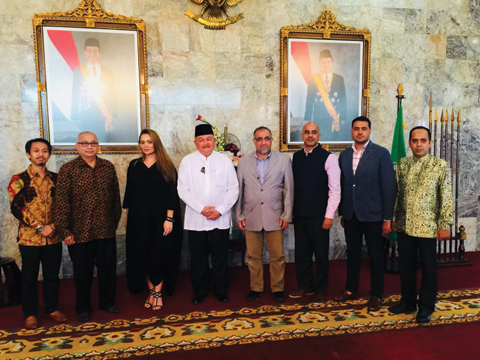Al-Quran Al-Akbar one of the most glorious experiences I felt throughout my visit
 A photo shows the Governor of South Sumatra Alex Noerdin posing with the media delegation
A photo shows the Governor of South Sumatra Alex Noerdin posing with the media delegationFrom Puncak we proceed to Halim Perdana Kusuma Airport and flew to Palambang. We reached Sultan Mahmud Badaruddin II International airport and checked in at the five-star Arista Hotel Palembang. Palembang is the second largest city on Sumatra Island after Medan, and is the capital city of South Sumatra province. It is considered to be one of the oldest cities in Indonesia, and has a history of being the capital city of the Kingdom of Srivijaya.
It is located on the Musi riverbank on the east coast of southern Sumatra. Palembang’s main landmarks include Ampera Bridge and Musi River, which divides the city into two. The first thing you notice in Palambang when you reach there is the construction work in preparation for the 18th Asian Games, which is going to be held in the city along with Jakarta. The second thing you notice is the Dutch influence on the architecture of the buildings. Palembang is different in its structure and architecture from Jakarta and Puncak.
The houses are like small villas with triangular red roofs, and some of the houses’ foundations are elevated from the ground for protection from wild animals. Their facades are painted in bright colors. The houses or villas are next to each other - it is a cozy place to visit.
Economy and the 18th Asian games
During our visit to this exceptional city, we were honored to meet the Governor of South Sumatra Alex Noerdin in his office. After welcoming us, we were sent to the conference room, where we watched a presentation about the history of Palambang in general, the preparations for the 18th Asian Games, the strength of its economic growth and future plans.
The governor started his speech by briefing us about South Sumatra. The city has a developed economy and strong population growth. It’s a unique and historical province with delicious food and great sports facilities.
“South Sumatra Province is divided into four cities and 17 regions separated by water and rivers. It is a great investment destination, with abundant natural resources all over the region and a large and growing domestic market, combined with an improving infrastructure and investment climate. It also has a higher global profile - these are just a few of South Sumatra’s salient strengths,” the governor said.
Two economic driving forces surround South Sumatra - the first is Singapore as the biggest regional hub and key trading partner, and Java as the biggest regional market.
“South Sumatra has many natural resources that make it very productive, such as coal, natural gas, petroleum, oil and rice. We are preparing a rice project by 2021 that can supply all of Indonesia. It also has rubber (considered to be the largest producer in the world) and coffee (also considered to be the best coffee in the world), among others,” Noerdin added. South Sumatra is the largest province on the island, covering up to 92,000 sqkm. It is three times bigger than any province in Java. But South Sumatra’s population is only a fifth of West Java, which makes it more flexible for spatial planning. As for hosting the 18th Asian Games, the governor had many interesting things to highlight, especially that this phenomenal project took two years to complete at a cost of more than 72 trillion rupiahs for the infrastructure and refurbishment of the airport and roads. “We started to build the Jakabaring Sport Complex in August 2016 and we are proud to say it is almost finished today. We are very pleased to host the 18th Asian Games in South Sumatra, and we are completely ready for it. We have more than 2,000 workers ready to help round the clock. There are 30 public toilet facilities, the swimming pool is made of stainless steel and is 25 meters long, a shooting range, a water polo building, eight tennis courts with around 7,000 individual seats, a gymnastics building and three buildings that can accommodate 8,500 athletes,” Noerdin said.
The governor continued to describe this extraordinary sport complex and the efforts that the city and government are exerting. “It’s 44 km from the airport to Jakabaring Sport Complex, and we have built a special light rail that connects it from the airport for the tourists, athletes and anyone that is interested to visit and be part of it,” he said. He ended his speech by saying: “We might not be the largest, nor the biggest, but we have the strongest motivation.”
Our trip ended in Palambang. We then proceeded to the new airport skytrain, then to Doha and back to Kuwait. It took us nine hours and 15 minutes. So back to the question: Is it worth it? Yes, it is definitely worth it. It is worth it because of the friendly and genuine people, the amazing and authentic food, the divine nature that they are blessed to have and their efforts to save it, for their love and compassion for animals which is seen through their zoos and animal reservations, for their colorful and outstanding batik outfits that differentiate them from other cultures, exceptional handmade wood carving, for their appreciation of education, their love for music, and last but not the least, it is worth it for their generous and spiritual nature.
By Sahar Moussa









